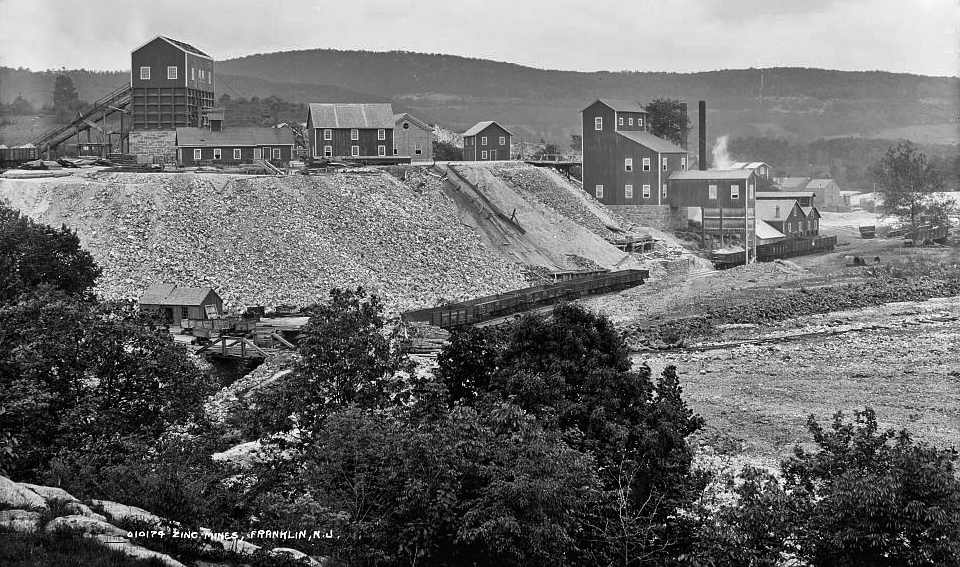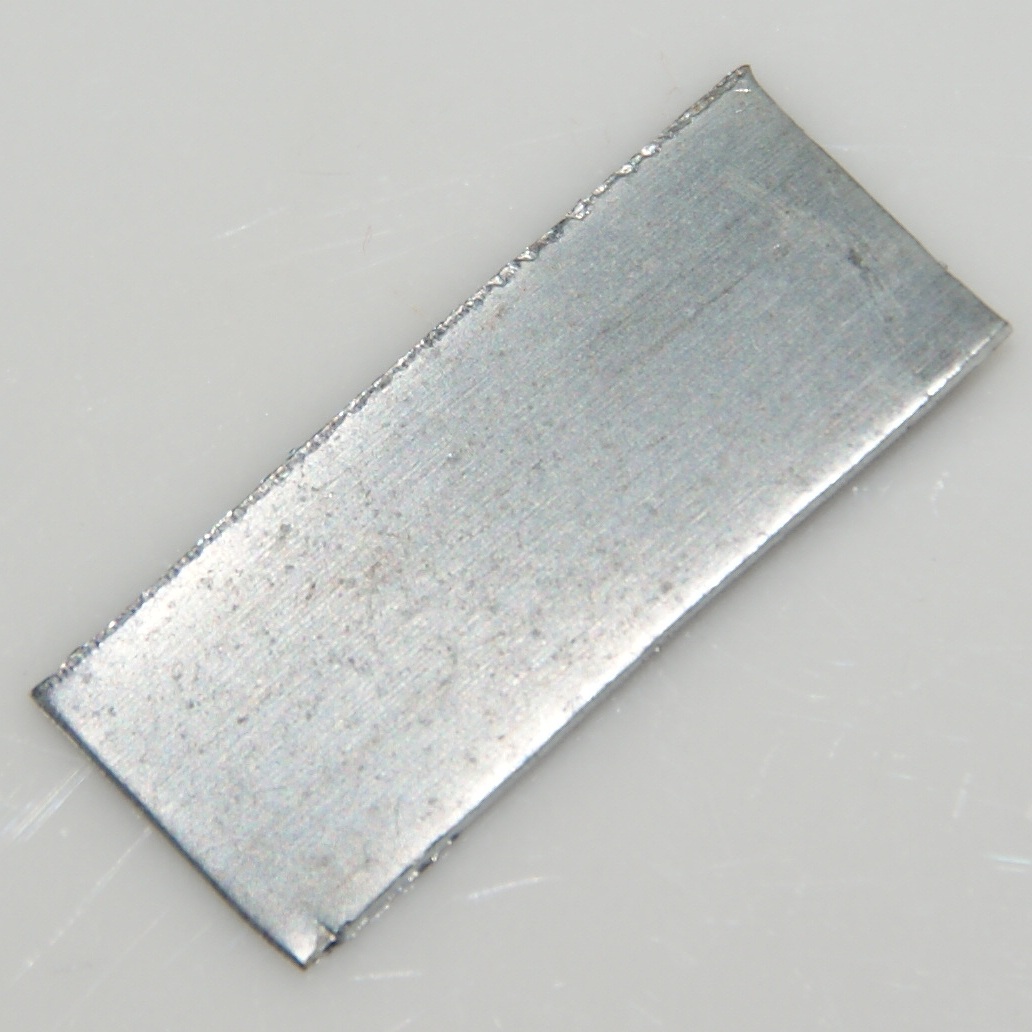|
Franklinite
Franklinite is an oxide mineral belonging to the normal spinel subgroup's iron (Fe) series, with the formula Zn2+Fe23+O4. As with another spinel member magnetite, both ferrous (2+) and ferric (3+) iron may be present in franklinite samples. Divalent iron and/or manganese (Mn) may commonly accompany zinc (Zn) and trivalent manganese may substitute for some ferric iron. At its type locality, franklinite can be found with a wide array of minerals, many of which are fluorescent. More commonly, it occurs with willemite, calcite, and zincite. In these rocks, it forms as disseminated small black crystals with their octahedral faces visible at times. It may rarely be found as a single large euhedral crystal. Franklinite is a major ore of the element zinc. It is named after its local discovery at the Franklin Mine and Sterling Hill Mines in New Jersey. In 2023, Franklinite was designated the state mineral of New Jersey. See also * Classification of minerals * List of minerals ... [...More Info...] [...Related Items...] OR: [Wikipedia] [Google] [Baidu] |
Franklin Furnace
Franklin Furnace, also known as the Franklin Mine, is a famous mineral location for rare zinc, iron, and manganese minerals in old mines in Franklin, Sussex County, New Jersey, United States. This locale produced more species of minerals (over 300) and more different fluorescent minerals than any other location. The mineral association (assemblage) from Franklin includes willemite, zincite and franklinite. During the mid-to-late 19th century the furnace was the center of a large iron making operation. Russian, Chilean, British, Irish, Hungarian and Polish immigrants came to Franklin to work in the mines, and the population of Franklin swelled from 500 (in 1897) to over 3,000 (in 1913).Truran, William R. ''Images of America: Franklin, Hamburg, Ogdensburg, and Hardyston''. (Charleston, South Carolina: Arcadia Publishing, 2004). The Furnace mine, which was adjacent to the actual furnace, was a 120+ foot vertical shaft just under Franklin Falls. Other rare minerals ... [...More Info...] [...Related Items...] OR: [Wikipedia] [Google] [Baidu] |
Sterling Hill Mining Museum
The Sterling Hill Mine, now known as the Sterling Hill Mining Museum, is a former zinc mine in Ogdensburg, Sussex County, New Jersey, United States. It was the last working underground mine in New Jersey. It closed in 1986, and became a museum in 1989. Along with the nearby Franklin Mine, it is known for its variety of minerals, especially the fluorescent varieties. It was added to the National Register of Historic Places in 1991. History Mining began at the site in the 1630s, when it was mistakenly thought to be a copper deposit. George III of the United Kingdom granted the property to William Alexander, titled Lord Stirling. Stirling sold it to Robert Ogden in 1765. It went through several owners until the various mines were combined into the New Jersey Zinc Company in 1897. The mine closed in 1986 due to a tax dispute with the town, which foreclosed for back taxes in 1989 and auctioned the property to Richard and Robert Hauck for $750,000. It opened as a museu ... [...More Info...] [...Related Items...] OR: [Wikipedia] [Google] [Baidu] |
Zincite
Zincite is the mineral form of zinc oxide ( Zn O). Its crystal form is rare in nature; a notable exception to this is at the Franklin and Sterling Hill Mines in New Jersey, an area also famed for its many fluorescent minerals. It has a hexagonal crystal structure and a color that depends on the presence of impurities. The zincite found at the Franklin Furnace is red-colored, mostly due to iron and manganese dopants, and associated with willemite and franklinite. Zincite crystals can be grown artificially, and synthetic zincite crystals are available as a by-product of zinc smelting. Synthetic crystals can be colorless or can range in color from dark red, orange, or yellow to light green. Both natural and synthetic zincite crystals are significant for their early use as semiconductor crystal detectors in the early development of crystal radios before the advent of vacuum tubes. As an early radio detector it was used in conjunction with another mineral, galena, and this ... [...More Info...] [...Related Items...] OR: [Wikipedia] [Google] [Baidu] |
Willemite
Willemite is a zinc silicate mineral () and a minor ore of zinc. It is highly fluorescent (green) under shortwave ultraviolet light. It occurs in a variety of colors in daylight, in fibrous masses and apple-green gemmy masses. Troostite is a variant in which part of the zinc is partly replaced by manganese, it occurs in solid brown masses. It was discovered in 1829 in the Belgian Vieille-Montagne mine. Armand Lévy was shown samples by a student at the university where he was teaching. Lévy named it after William I of the Netherlands (it is occasionally spelled villemite). The troostite variety is named after Dutch-American mineralogist Gerard Troost. Occurrence Willemite is usually formed as an alteration of previously existing sphalerite ore bodies, and is usually associated with limestone. It is also found in marble and may be the result of a metamorphism of earlier hemimorphite or smithsonite. Crystals have the form of hexagonal prisms terminated by rhombohedral planes: ... [...More Info...] [...Related Items...] OR: [Wikipedia] [Google] [Baidu] |
Oxide Minerals
The oxide mineral class includes those minerals in which the oxide anion (O2−) is bonded to one or more metal alloys. The hydroxide-bearing minerals are typically included in the oxide class. Minerals with complex anion groups such as the Silicate mineral, silicates, Sulfate mineral, sulfates, carbonate mineral, carbonates and Phosphate mineral, phosphates are classed separately. Simple oxides *XO form **Periclase group ***Periclase ***Manganosite **Zincite group ***Zincite ***Bromellite ***Tenorite ***Litharge * form **Cuprite **Ice * form **Hematite group ***Corundum ***Hematite ***Ilmenite * form **Rutile group ***Rutile ***Pyrolusite ***Cassiterite **Baddeleyite **Uraninite **Thorianite * form **Spinel group ***Spinel ***Gahnite ***Magnetite ***Franklinite ***Chromite **Chrysoberyl **Columbite *Hydroxide subgroup: **Brucite **Manganite **Romanèchite **Goethite group: ***Diaspore ***Goethite Nickel–Strunz class 4: oxides Internationa ... [...More Info...] [...Related Items...] OR: [Wikipedia] [Google] [Baidu] |
Cubic Minerals
Cubic may refer to: Science and mathematics * Cube (algebra) In arithmetic and algebra, the cube of a number is its third exponentiation, power, that is, the result of multiplying three instances of together. The cube of a number is denoted , using a superscript 3, for example . The cube Mathematical ..., "cubic" measurement * Cube, a three-dimensional solid object bounded by six square faces, facets or sides, with three meeting at each vertex ** Cubic crystal system, a crystal system where the unit cell is in the shape of a cube * Cubic function, a polynomial function of degree three * Cubic equation, a polynomial equation (reducible to ''ax''3 + ''bx''2 + ''cx'' + ''d'' = 0) * Cubic form, a homogeneous polynomial of degree 3 * Cubic graph (mathematics - graph theory), a graph where all vertices have degree 3 * Cubic plane curve (mathematics), a plane algebraic curve ''C'' defined by a cubic equation * Cubic reciprocity (mathematics - number theory), a theorem ana ... [...More Info...] [...Related Items...] OR: [Wikipedia] [Google] [Baidu] |
Zinc Minerals
Zinc is a chemical element; it has Symbol (chemistry), symbol Zn and atomic number 30. It is a slightly brittle metal at room temperature and has a shiny-greyish appearance when oxidation is removed. It is the first element in group 12 element, group 12 (IIB) of the periodic table. In some respects, zinc is chemically similar to magnesium: both elements exhibit only one normal oxidation state (+2), and the Zn2+ and Mg2+ ions are of similar size. Zinc is the 24th most abundant Abundance of elements in Earth's crust, element in Earth's crust and has five stable isotopes. The most common zinc ore is sphalerite (zinc blende), a zinc sulfide mineral. The largest workable lodes are in Australia, Asia, and the United States. Zinc is refined by froth flotation of the ore, Roasting (metallurgy), roasting, and final extractive metallurgy, extraction using electricity (electrowinning). Zinc is an essential trace element for humans, animals, plants and for microorganisms and is necessary fo ... [...More Info...] [...Related Items...] OR: [Wikipedia] [Google] [Baidu] |
Iron(III) Minerals
Iron is a chemical element; it has symbol Fe () and atomic number 26. It is a metal that belongs to the first transition series and group 8 of the periodic table. It is, by mass, the most common element on Earth, forming much of Earth's outer and inner core. It is the fourth most abundant element in the Earth's crust, being mainly deposited by meteorites in its metallic state. Extracting usable metal from iron ores requires kilns or furnaces capable of reaching , about 500 °C (900 °F) higher than that required to smelt copper. Humans started to master that process in Eurasia during the 2nd millennium BC and the use of iron tools and weapons began to displace copper alloys – in some regions, only around 1200 BC. That event is considered the transition from the Bronze Age to the Iron Age. In the modern world, iron alloys, such as steel, stainless steel, cast iron and special steels, are by far the most common industrial metals, due to their mechanical proper ... [...More Info...] [...Related Items...] OR: [Wikipedia] [Google] [Baidu] |
Spinel
Spinel () is the magnesium/aluminium member of the larger spinel group of minerals. It has the formula in the cubic crystal system. Its name comes from the Latin word , a diminutive form of ''spine,'' in reference to its pointed crystals. Properties Spinel crystallizes in the isometric system; common crystal forms are octahedron, octahedra, usually Crystal twinning, twinned. It has no true Cleavage (crystal), cleavage, but shows an octahedral Parting (crystal), parting and a conchoidal fracture. Its Mohs scale of mineral hardness, hardness is 8, its specific gravity is 3.5–4.1, and it is transparent to opaque with a vitreous to dull Lustre (mineralogy), luster. It may be colorless, but is usually various shades of red, lavender (color), lavender, blue, green, brown, black, or yellow. Chromium(III) causes the red color in spinel from Burma. Some spinels are among the most famous gemstones; among them are the Black Prince's Ruby and the "Timur ruby" in the British Crown Jewels ... [...More Info...] [...Related Items...] OR: [Wikipedia] [Google] [Baidu] |
List Of Minerals
This is a list of minerals which have Wikipedia articles. Minerals are distinguished by various chemical and physical properties. Differences in chemical composition and crystal structure distinguish the various ''species''. Within a mineral species there may be variation in physical properties or minor amounts of impurities that are recognized by mineralogists or wider society as a mineral ''variety''. Mineral variety names are listed after the valid minerals for each letter. For a more complete listing of all mineral names, see List of minerals recognized by the International Mineralogical Association. A :Varieties that are not valid species: *Adamantine spar (variety of corundum) *Agate (variety of chalcedony and quartz) *Alabaster (variety of gypsum) *Alexandrite (variety of chrysoberyl) *Allingite (synonym of amber) *Alum *Amazonite (variety of microcline) *Amethyst (purple variety of quartz) *Ametrine (variety of quartz) *Ammolite (organic; also a gemstone) *Amos ... [...More Info...] [...Related Items...] OR: [Wikipedia] [Google] [Baidu] |
Classification Of Minerals (other)
The classification of minerals is a process of determining to which of several groups minerals belong based on their chemical characteristics. Since the 1950s, this classification has been carried out by the International Mineralogical Association, which classifies minerals into the following broad classes: *Classification of non-silicate minerals * Classification of silicate minerals * Classification of organic minerals See also * List of minerals This is a list of minerals which have Wikipedia articles. Minerals are distinguished by various chemical and physical properties. Differences in chemical composition and crystal structure distinguish the various ''species''. Within a mineral speci ... External links * {{SIA ... [...More Info...] [...Related Items...] OR: [Wikipedia] [Google] [Baidu] |





